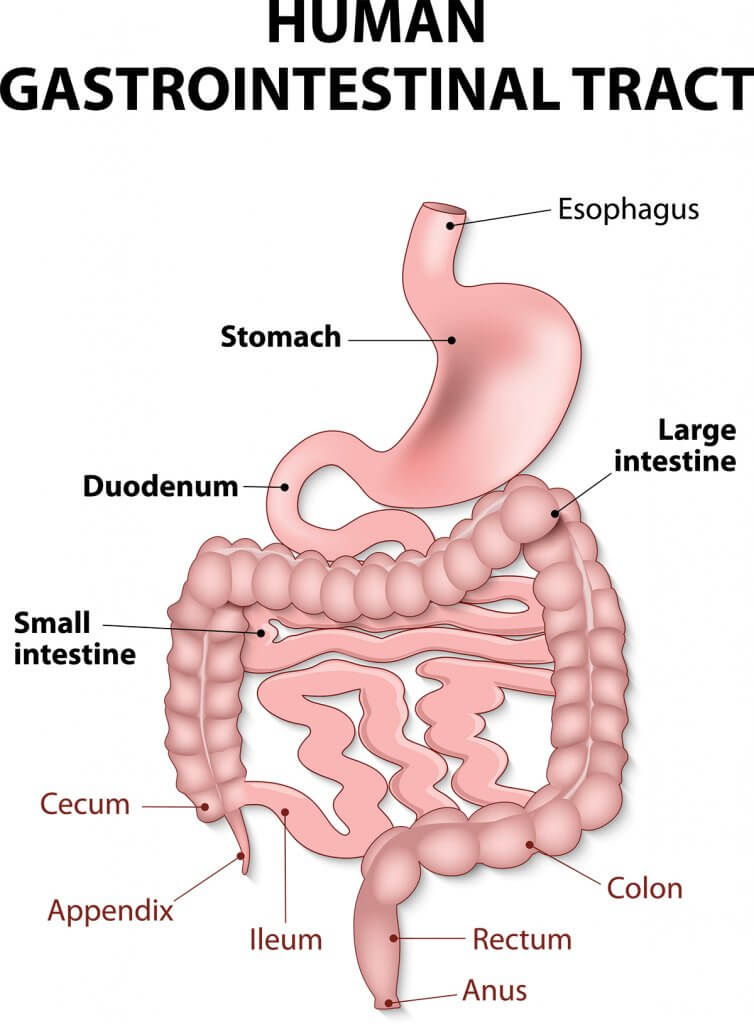All About the Upper GI Tract

Your digestive system, or gastrointestinal (GI) tract, is responsible for digesting food and processing it to fuel your body. The GI system is divided into two sections: the upper GI tract and the lower GI tract. The upper GI tract is responsible for starting digestion and preparing it for the lower GI tract to process and absorb nutrients. Several common gastrointestinal disorders occur in the different parts of the upper part of the GI tract.
Anatomy of the Upper GI Tract
Mouth
The mouth is the first part of the upper GI tract, and therefore the first component of the digestive system as a whole. Glands in the mouth secrete saliva, which mixes with the food as you chew to help it soften. Saliva contains an enzyme called amylase, which immediately starts to break down carbohydrates in the mouth. Once the food is soft enough to swallow, it moves into the throat or pharynx.
Pharynx
The pharynx, or throat, is a 5-inch long passageway that has a dual function. The pharynx carries both food and air. Swallowed food moves down the pharynx before it enters the esophagus.
Esophagus
The esophagus is a hollow muscular tube that connects the throat to the stomach through an opening in the diaphragm. It usually measures about 10 inches long and has a ring of muscle called a sphincter on either end. The upper esophageal sphincter relaxes to allow food to pass from the pharynx and closes to stop air from entering. The lower esophageal sphincter relaxes to let food pass into the stomach.
Stomach
The stomach is a sizeable bag-like organ in the upper abdomen. It holds the food you’ve eaten and continues the digestion started in the mouth. The stomach secretes digestive enzymes and gastric acid to help with digestion. The stomach stretches to accommodate the food and drinks we consume throughout the day. The stomach has four sections:
- Cardia
- Fundus
- Body
- Antrum
Duodenum
The duodenum is a C-shaped tube that forms the beginning of the small intestine. The common bile duct and the main pancreatic duct connect to the duodenum. These ducts carry bile and enzymes that help digest the food as it moves through the small intestine.
Disorders and Diseases of the Upper GI Tract
GERD (Gastroesophageal Reflux Disease)
Gastroesophageal reflux disease (GERD) is a back-flow of stomach contents into the esophagus. The most common symptom of GERD is heartburn, and some people experience regurgitation. The American College of Gastroenterology estimates that 60 million Americans experience heartburn at least once a month, but people suffering from GERD experience symptoms at least twice a week.
Esophageal Motility Disorders
When we swallow, the esophagus has to contract to move food toward the stomach. Esophageal motility is the term to describe this movement. The contractions must coordinate to swallow food successfully. When the contractions are irregular or absent, then swallowing becomes difficult or impossible. Common types of esophageal motility disorders include:
Barrett’s Esophagus
Barrett’s esophagus develops when the protective lining of the esophagus is damaged. People do not always experience symptoms, but it can increase the risk of developing cancer in the esophagus. Therefore, it’s crucial to speak to your doctor about your risks if you have GERD, are obese, smoke, or have a family history.
Cancer
The parts of the upper GI tract are susceptible to cancer, just like any other part of the body. Cancer can affect the esophagus, stomach, or small intestine.
Peptic Ulcers
Peptic ulcers are open sores in the lining of the stomach or duodenum. Peptic ulcers result from an imbalance in the enzymes and acids present for digestion. This imbalance will irritate and damage the protective mucosal lining of either organ. Ulcers in the stomach are called gastric ulcers, and ulcers at the beginning of the small intestine are called duodenal ulcers.
Diagnosing and Treating Upper GI Tract Disorders
If you are experiencing symptoms of an upper GI disorder, your doctor will begin with a physical exam and detailed medical history. Based on the doctor’s findings, they may refer you to a gastroenterologist for further testing. A gastroenterologist may use diagnostic tests like an upper GI endoscopy to look at your esophagus.
Treatment options depend on the type of disorder and its severity. For a condition like GERD, lifestyle changes, weight loss, and dietary alterations can make a difference. Other times medications or even surgery are available to alleviate symptoms.
At Birmingham Gastroenterology, we use the latest diagnostic and treatment methods to treat our patients. To talk to a board-certified gastroenterologist in the Birmingham, AL area, call (205) 271-8000 to make an appointment.

